by Martin Sat Nov 16, 2024 6:31 pm
» targeting artillery targets
by Saucier Tue Oct 29, 2024 12:15 am
» Grog can't make it
by Grog Fri Sep 13, 2024 5:59 pm
» Toggle vegetation = true not working
by popeadrian Fri Aug 30, 2024 11:43 pm
» 1862 Kriegsspiel manual by Von Tschiscwitz
by modron Thu Aug 29, 2024 8:23 pm
» SOW Scenario Generator
by popeadrian Sun Aug 25, 2024 5:39 pm
» Guide to map making?
by popeadrian Wed Aug 14, 2024 1:44 am
» SOWWL Artillery batteries
by Uncle Billy Thu Jul 11, 2024 3:15 pm
» Set Up for SOWWL NAPOLEON GAMES For Kriegspiel style
by Uncle Billy Tue Jul 09, 2024 10:35 pm
» The New SOWWL Is Now Available On Steam
by Grog Mon Jul 08, 2024 8:14 pm
» Boxed KS set Wallington NT near Morpeth
by Martin Sat Jun 08, 2024 3:50 pm
» Help Request-Artillery Behavior
by Dutch101 Mon May 27, 2024 4:08 pm
The newest registered user is Moromir
Our users have posted a total of 30539 messages in 2305 subjects
AAR Isle of Wight 1805 Napoleonic Kriegsspiel
Page 1 of 2 • 1, 2 
 AAR Isle of Wight 1805 Napoleonic Kriegsspiel
AAR Isle of Wight 1805 Napoleonic Kriegsspiel
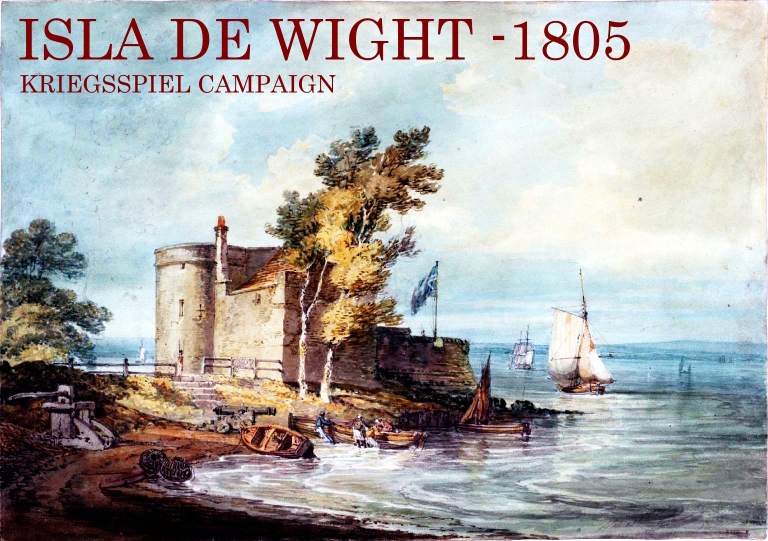
Ladies and gentlemen,
I'm going to try to make a small AAR of the game that we are playing these weeks with two friends whose objective is to conquer the Isle of Wight in the year 1805. The idea is taken from a simple game hex-based named "Vectis" that was published by Draken Games in 2007, 2009 and 2013, being the author Mark Wightman.
At the time I bought the rules and elements of the game, but I never play it, although it was an interesting "What if" for the Napoleonic era, but in the strict historical sense its possession did not make much sense, especially with the mastery of the Royal Navy of its coasts and the Channel.
The Isle of Wight was a place that was used to train foreign troops of the British army, such as the KGL, which was stationed some time on the island.
On the other hand, I have never played the traditional krieggspiel, but its aesthetics and its approach to realism have always caught my attention. Nowadays, especially on YouTube, various initiatives have emerged to simplify the Prussian Krieggspiel, so I decided to start a game with myself acting as a referee/Umpire, for which I obtained a map of the island from the epoch that I modified and colored, some small rules and transporting everything to the TTS as a module and exchanging the orders by e-mail with the two players.
As you will see, it is not a traditional krieggspiel of exercising in a match between several opponents in a few hours. It is a mini-campaign, which we hope to resolve in a few weeks, and whose first turn is on August 15, 1805.
RULES (VERY SUMMARIZED)
I have ended up specifying the rules for the days in two turns per day, from 6 a.m. to 12 p.m. and from 12 p.m. to 8 p.m., that is, from dawn to dusk, in August on the island.
There was a third night turn, but in the end I don't use it not to complicate the development of the game.
The weather for the time is also based on the island of Wight weather, there are only 20% of days with rainfall in August, so I created a table with the weather distributed from CLEAR-FOG-RAIN between 2-12 and rolling 1D6 the weather for the turn, which can obviously vary each turn. The weather is the same for the whole island, considering that it is only about 30 km long.
I also created a table to know the French or British control of the seas for the landings and for the movements I have made them random, because the terrain is small and there were few roads as such and many rural roads.
Infantry and artillery: 1D6 km
Cavalry, commanders, patrols: 2D6 km
Couriers: 3D6 km
The combats will be resolved with traditional Krieggspiel dice but simplifying the results, without counting the losses with an exact number of soldiers or horsemen.
Some images:

The game scores the possession of objectives, the "capital" in the center of the island and the main villages that are in the northwest of the island. The number of units of each side that remain on the island at the end of the 12 days of the mini-campaign is also scored.

Militia units return to Newport.
I also wanted to introduce some role-playing element and based on an old First Empire magazine article, "S.C.O.D.I.T." by John Shelley who gave a series of attributes to generals to check their response to various situations. So, the two player had to select from a pool of 12 generals, 4 for every brigade. For the French player:
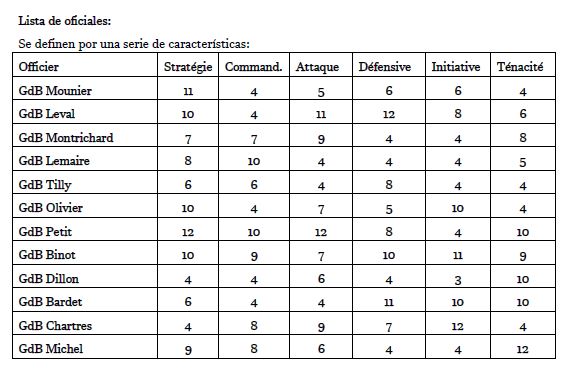
My first impressions are satisfactory (for now), although the reports and orders are writed, I am investing a lot of time (perhaps too much) in their paper transcription. On the other hand, one of the players knows the Napoleonic epoch, but the other does not, so it is difficult for him to pick up "the style" to name the units or generals, or "feel" a little immersion in this epoch. Patience...
Last edited by Chorch on Thu Feb 09, 2023 4:17 pm; edited 3 times in total
Mr. Digby likes this post
 AAR Isle of Wight 1805 Napoleonic Kriegsspiel
AAR Isle of Wight 1805 Napoleonic Kriegsspiel
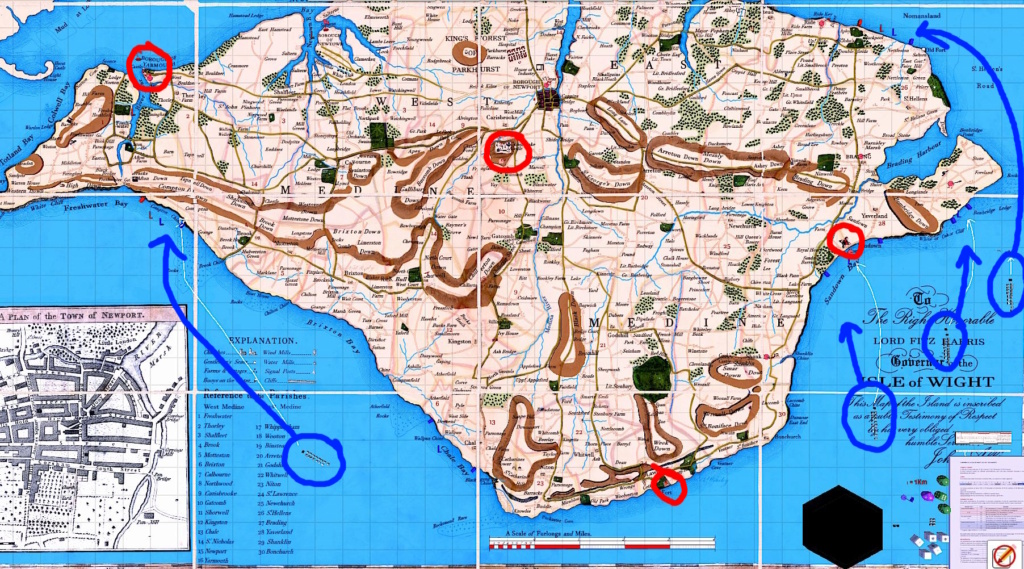
The French player leaves at 6 in the morning from the port of Cherbourg, there is a distance of about 107 to 120 km, depending on the landing place, so I calculated a march of about 14 km per hour for the fleet (almost 8 knots per hour, if my calculations do not fail me). Another problem is the landing of the troops: the beaches are not very wide and there are many cliffs, so the places to disembark are quite limited on the arrival side of the French fleet (South). Time is another factor, so calculating the disembarkation time of 20 men in 5 minutes (I got the data from the Internet, I don't remember the source), for a brigade it took about 15 hours to disembark (artillery and baggage aside). Therefore, the first day for French player was invested in crossing the channel and ensuring the landings.
The British player (stationed in Portsmouth) moves only when the signal arrives that the island is being invaded.
SECOND TURN
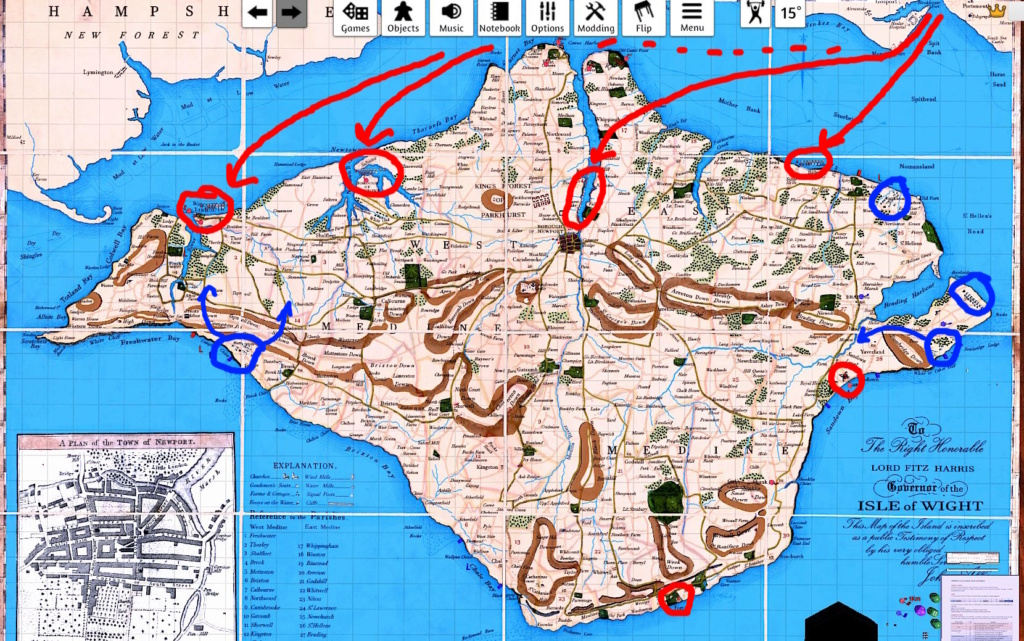

The traversing and disembark problem was the same for the British player, but with much less traversing time (2-4 hours) plus the more easy landing for the troops. The French player has landed in the indicated places, except Sandown beach, due to the presence of Fort Sandown, heavily armed. The island's governor previously ordered that the local militia (about 2,000 men) all assembled in the capital, Newport.
Mr. Digby likes this post
 Re: AAR Isle of Wight 1805 Napoleonic Kriegsspiel
Re: AAR Isle of Wight 1805 Napoleonic Kriegsspiel
I think you made reference to variable command of the sea earlier. So presumably the French have a chance to land more troops? I could imagine, in the conditions of 1805, that this would be increasingly difficult, once the powerful British Channel fleet had been alerted, but perhaps in periods of rain or mist?
Martin J
Martin- Posts : 2523
Join date : 2008-12-20
Location : London
Chorch likes this post
 Re: AAR Isle of Wight 1805 Napoleonic Kriegsspiel
Re: AAR Isle of Wight 1805 Napoleonic Kriegsspiel
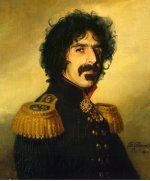
Mr. Digby- Posts : 5769
Join date : 2012-02-14
Age : 65
Location : UK Midlands
Chorch likes this post
 Re: AAR Isle of Wight 1805 Napoleonic Kriegsspiel
Re: AAR Isle of Wight 1805 Napoleonic Kriegsspiel
The premise is to start from the (uncertain) assumption that, at some point, the French were going to have such mastery of the sea to carry out the invasion. We all know that this circumstance did not occur and it was tremendously complicated for it to occur because one of the premises of the Earl of St. Vincent was precisely the ships of the Royal Navy did not leave the English coasts under any circumstances, the famous phrase: "I am not saying that the French cannot come, I am only saying that they will not come by sea."
So I made a table to "facilitate" the crossing and landing of the French brigades, we also didn't want the entire French army corps to finish this game at the bottom of the English Channel in the first turn...

First trow 1D10 and after 1D6 to see the final result.
As you see, there is less than a 10% chance that the French (or English) player will lose a brigade at sea. To be more historically accurate, the odds would have to be tremendously low...
But we assume that the Emperor's fantastic plan has worked, and the entire English fleet has gone after Villeneuve's French fleet into the Atlantic, then patiently waited for it to turn around, and even more patiently waited for the French troops to embark at all ports on the French coast, and in the height of chivalry they have allowed them to cross the English Channel unmolested...
We have planned a single landing of 4 brigades in the south of the Island, as a "secondary" or "terciary" front of the big invasion of England.
Certainly we could open up the possibilities and let more troops land, although reducing the possibilities.
The problem is that by itself it doesn't make much sense to occupy the Isle of Wight with many troops in an invasion when you're planning to get to London as quickly as possible.
The weather is the other factor, as you point out, but in August on the island, as I already said, if the Internet is not deceiving me there are 20% of days with bad weather (it would be about 6 days) so perhaps you would have a few hours or a few days "in transit" to be able to disembark, although with many odds against it by the presence of Royal Navy ships.
Last edited by Chorch on Mon Jan 30, 2023 7:22 pm; edited 1 time in total
Mr. Digby likes this post
 Re: AAR Isle of Wight 1805 Napoleonic Kriegsspiel
Re: AAR Isle of Wight 1805 Napoleonic Kriegsspiel
I think that's fine, Chorch. It's a kriegsspiel after all, and as far as we know, all of the 19th C Prussian training games were hypothetical, however unlikely.
And how typical of us sporting Brits, to allow the Corsican Ogre to get his troops across
Martin- Posts : 2523
Join date : 2008-12-20
Location : London
Mr. Digby and Chorch like this post
 Re: AAR Isle of Wight 1805 Napoleonic Kriegsspiel
Re: AAR Isle of Wight 1805 Napoleonic Kriegsspiel
The perfidious Albion is not as perfidious as it seemed
Martin likes this post
 Re: AAR Isle of Wight 1805 Napoleonic Kriegsspiel
Re: AAR Isle of Wight 1805 Napoleonic Kriegsspiel
Very impressed by your pioneering work on TTS, it looks fantastic!
As for myself, I occasionally run Kriegsspiels on offbeat and unusual subjects and have been looking to run one based on eighteenth century anti-smuggling operations on the British coast, but have been unable to find a completely suitable map. However, I feel your IOW map would fit perfectly!
I wonder if you would be willing to share the original graphic version?
I do personally share a number of my original maps, which are mostly visible at THE ALTERNATIVE CHILTERN KRIEGSSPIEL SITE and would of course return the favour should you be interested in future in any of them. A lot of them can be downloaded immediately from that site, and I have a lot more at THIS PINTEREST SITE
You should be able to message me shortly from this forum, so I can send you email details; alternatively there is a contact form on the website which comes through to me.
Please do keep uploading!
Chorch likes this post
 Re: AAR Isle of Wight 1805 Napoleonic Kriegsspiel
Re: AAR Isle of Wight 1805 Napoleonic Kriegsspiel
First, thank you very much for your words.
I think I entered in your website a while ago, it has interesting sections, such as orders, for example, among others.
No problem. You have the original map in:
Map of Isle of Wight
First I suggest you take a look at it, it can be expanded quite a bit and more than anything to see if it fits your idea. This would be the old basic style.
I limited myself to coloring and overwriting the letters, I was lucky to hit the type of text (Javanese type), so it fits quite well.
In fact, it's a very good idea to simulate smuggling embarkations and landings, although much of the coastline are cliffs...
If you want our game color version (not TTS), no problem, give me a private email if you want and I'll send you,
or I could also post it in another section for everyone in the forum to reach.
Today or tomorrow I'll post the third turn...
Mr. Digby likes this post
 Re: AAR Isle of Wight 1805 Napoleonic Kriegsspiel
Re: AAR Isle of Wight 1805 Napoleonic Kriegsspiel
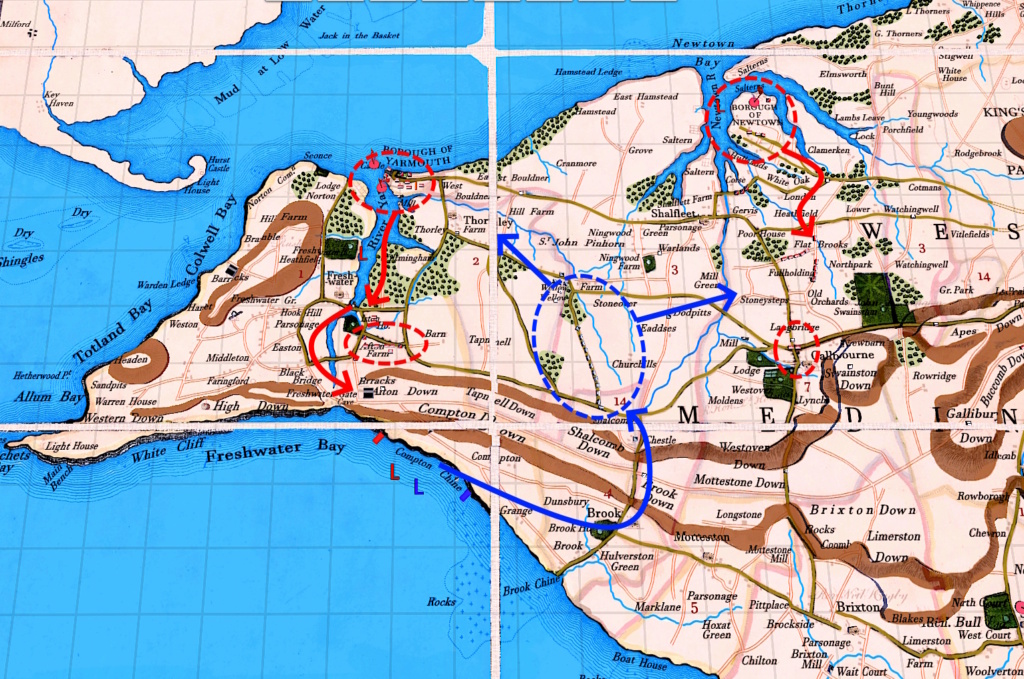
3rd Turn - August 26, 1815 at 6 in the morning (WEST SIDE): Part of the 4th British brigade under the command of BG McKenzie has been divided between its cantonment, Yarmouth, and Afton Farm in the south of the island, not far from the French landing place, to prevent a flanking attack. For its part, the 2nd British brigade of BG Fullerton moves quickly from Newton, to locate the enemy and guard the road to the capital. The French player has managed to clear the mountains in the south and bring his brigade towards the plains on Wellow Wellow, on the rear of the capital, which allows him several options such as attacking Yarmouth to the northwest, turning towards Newton to the north or if he manages to get rid of the Fullerton's brigade, to threaten the capital from the rear of its defensive line, although with the risk of being trapped between the two British brigades, so the next few turns will clear up our doubts.

3rd Turn - August 26, 1815 at 6 in the morning (EAST SIDE): The 1st British brigade prepares to defend the capital supported by the nearby Fort Carisbrooke and the Medina river that runs through Newport. The 3rd brigade from BG Hill at Ride could try to attack the enemy from the rear as they move south to meet up with the other two French brigades and then come to the defense of the capital... It is a choice... or withdraw towards Newport without engaging in combat and protecting its rearguard. For his part, the French player goes directly towards the capital with his 1st brigade advancing through Messly Down and I think his intention was to advance in parallel through the south of the hills and appear from the south of the capital with its 2nd brigade, although with the delay in his landing, this option appears unfeasible. In the next few turns the fate of Newport will be decided, although without a coordinated attack by more than one brigade, it seems like a tough nut to crack, but who knows?

A view of the capital Newport and Fort Carisbrooke and the advancing French column.
Mr. Digby likes this post
 Re: AAR Isle of Wight 1805 Napoleonic Kriegsspiel
Re: AAR Isle of Wight 1805 Napoleonic Kriegsspiel
It would be very appreciated if you could do that. I like your version as you have cleaned it up a good deal and emphasized high ground, etc.

Mr. Digby- Posts : 5769
Join date : 2012-02-14
Age : 65
Location : UK Midlands
 Re: AAR Isle of Wight 1805 Napoleonic Kriegsspiel
Re: AAR Isle of Wight 1805 Napoleonic Kriegsspiel
m
Martin- Posts : 2523
Join date : 2008-12-20
Location : London
 Re: AAR Isle of Wight 1805 Napoleonic Kriegsspiel
Re: AAR Isle of Wight 1805 Napoleonic Kriegsspiel
The colored map I think is about 90 Mb, so I have put the link directly to the cloud.
Mr. Digby likes this post
 Re: AAR Isle of Wight 1805 Napoleonic Kriegsspiel
Re: AAR Isle of Wight 1805 Napoleonic Kriegsspiel
(Due to a transcription error, the campaign really started on August 15, not August 25, so we moved the calendar back to the correct day... Beginner's mistake!

The 3rd French Brigade has entrenched itself in the village of Wellow Wellow and the nearby farm and woods, and it does not appear that they will be able to escape the attack of the British 2nd Brigade from the east and the 4th Brigade from the south. It's not a bad defensive position but the odds are is 2:1, despite the fact that the British player has left some troops to defend Yarmouth and Newton, two of the objectives of the campaign. There is an error in the text, the British cavalry unit is the 5th Hussars and not light dragoons
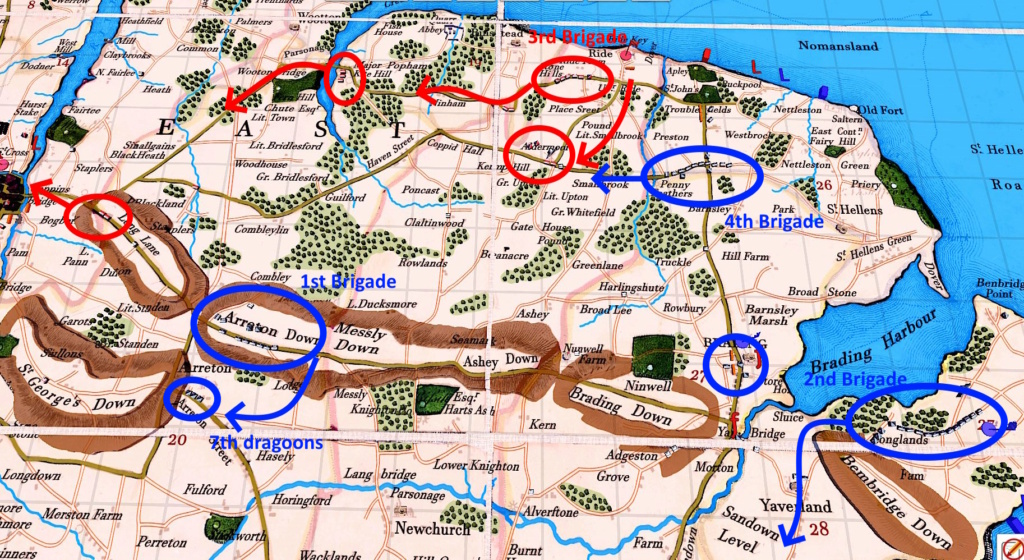
On the east side of the island, the 1st French Brigade is at Arreton Down, preparing to attack the capital. The problem (and not the least) for the French player is that the British 3rd Brigade has left Ride and is going rapidly with forced marches towards the capital via the northern route, and, probably, they will arrive in time to defend the capital or to attack the 1st French brigade on its right flank. The other two French brigades are moving slowly to the west, and the 2nd brigade has been ordered to attack Fort Sandown, an strange manoeuvre, because an entire brigade is used to attack a minor objective and is distracted from the objective of attacking the capital with greater guarantees.
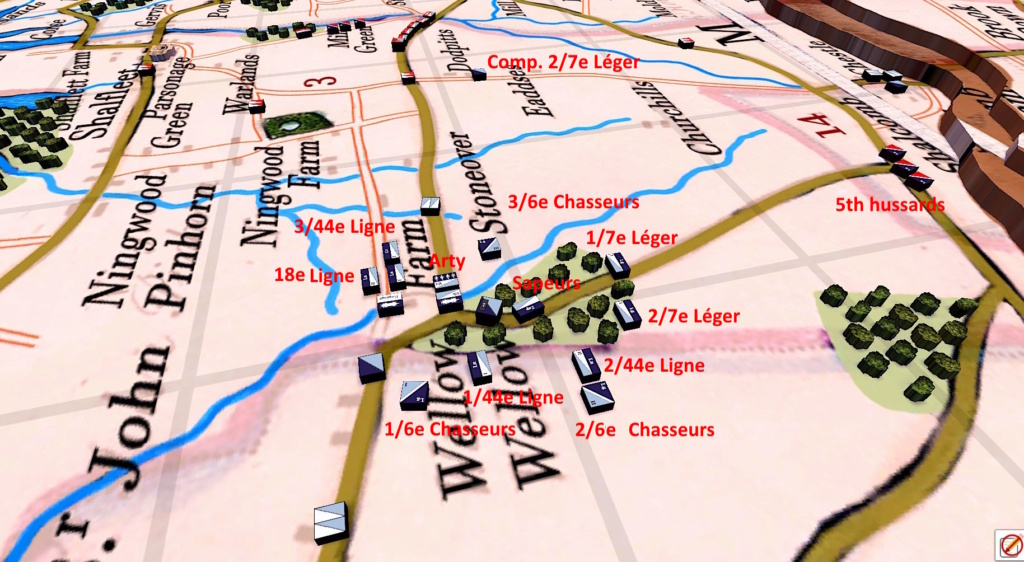
The units of the 3rd French brigade around Wellow Wellow and the woods.
THE FOUR FIRST TURNS, PROS AND CONS
PROS: It's been quite an interesting experience, both for me and for the two players. The rhythm of the turns was is expected, and some maneuvers are being interesting.
CONS: On the negative side, although it was already expected, as a Umpire it took me 2-3 hours to write the dispatches of the brigade commanders of the two armies as well as of the cavalry patrols, four patrols per brigade on each side. There are also problems to identify some places or not describe the exact route where a unit has to march. Due to the map size sometimes it's not easy to locate the cavalry vedettes or patrols of the players...
Another aspect is the movement of units. Due to the size of the island, I tried to limit the movement so as not to finish the campaign in two days, so to speak, but in the case of the infantry, having it controlled by a roll of 1D6 kilometers gives too great a dispersion , so results less than 2 are going to have to be discarded so as not to affect the rhythm of the game.
About the "flow" of the game, as has happened to me in other board wargames, there does not seem to be a clear strategy on the part of both players to try to coordinate the four brigades under their command, that is, to locate the enemy, preserve the objectives (if they are possessed) but trying to have a coordinated and supportive action between the brigades.
Martin, Mr. Digby and Regor like this post
 Re: AAR Isle of Wight 1805 Napoleonic Kriegsspiel
Re: AAR Isle of Wight 1805 Napoleonic Kriegsspiel
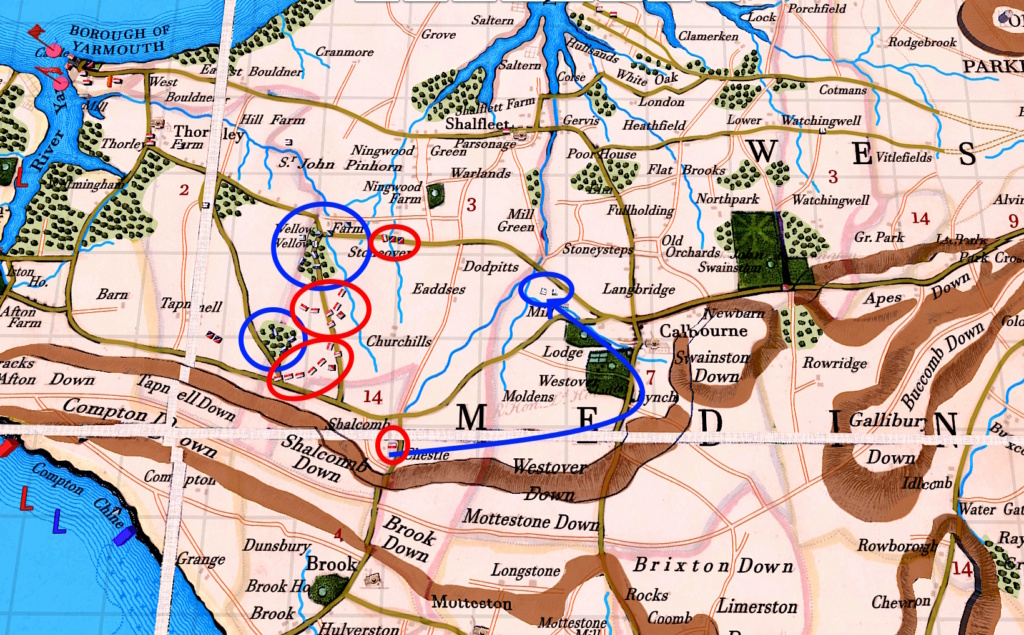
(WEST SIDE) General Chartres's 3rd French Brigade desperately tried to force its way back into the hills of Shalcomb Down as ordered, but was blocked by BG McKenzie's 4th Brigade, causing the two brigades to clash between the southern woods and the village of Churchills. The French initial advantage seemed to allow it to evade the encirclement, but BG Fullerton's brigade from the east managed to link its lines with those of the 4th Brigade, forcing Chartres to return to its initial positions of the morning, and with his forces divided between the two forests. Chartres is managing to hold the two English brigades, buying time for the rest of the French force to seize the center of the island and the capital, but its resistance may not last another day...
The few French forces at Shalcomb, despite successfully defending the village from English cavalry, were dislodged by the Grenadiers of the British 54th Line. The two French horse patrols gained the heights and managed to come near Dodpitts after a wide detour.
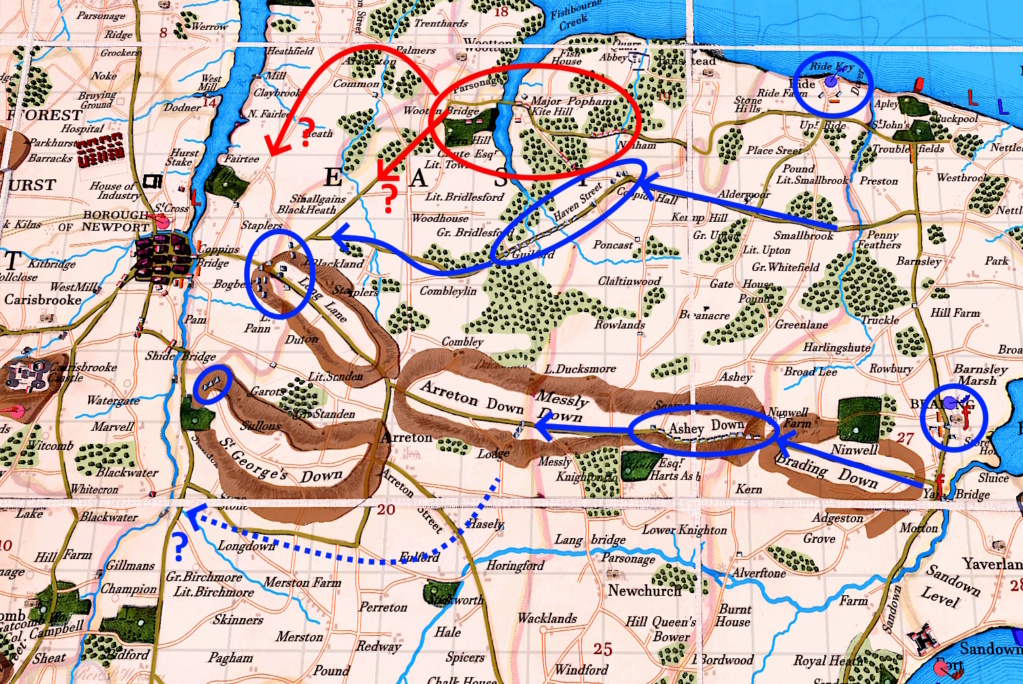
(EAST SIDE) In the eastern part of the island things seem to be going better for the French player. General Leval's French 1st Brigade with its Commander-in-Chief has already arrived in front of the capital, closely followed by General Petit's 2nd Brigade, which could join the 1st Brigade for the planned attack on the capital or bypass to the south, at Blackwater the river pass which is protected only by a squadron of the British 7th Light Dragoons. General Binot's 4th Brigade descends from the north, having occupied Ride and will join the 1st Brigade on the right flank. The capital is protected by the English 1st Brigade and has seen its defenses improved by sappers, although the batteries of nearby Carisbrooke Castle do not seem likely to be of effective help in defending the city. For its part, General Hill's British brigade, after leaving Ride, runs along the northern road, and will probably try to attack the French right flank to divert the defense of the capital from its attackers.
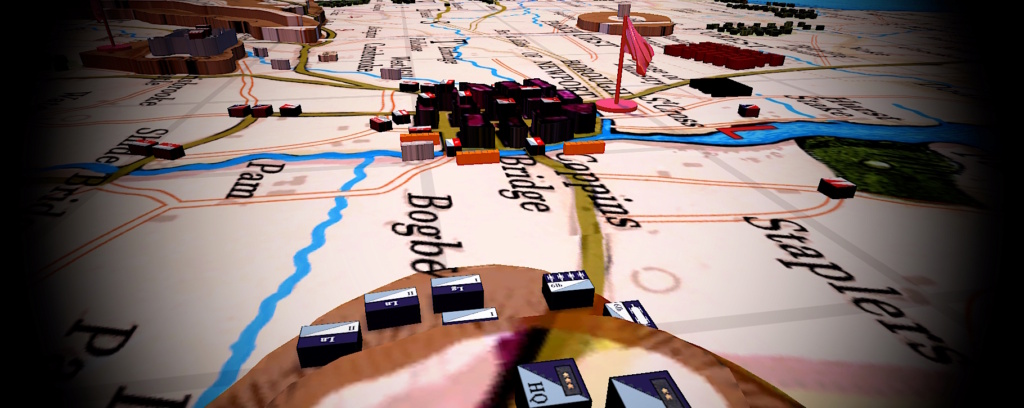
A view of the capital from the near heights of Long Lane, from the French lines.
BATTLE OF WELLOW WELLOW
The Battle of Wellow Wellow had different phases, but the French player was unable to reach Shalcomb and the pass into the hills. Another alternative would have been to force the passage towards the capital, and in case of success, threaten the rear of the Newport's defense, but, equally, it is difficult with a 2:1 disadvantage, to be able to reach desirable objectives, beyond trying to hold down the two British brigades in that theater of operations...

Initially, the Chartres French brigade attacks the British brigade to the south, who support their defense in the woods, although their cavalry has moved as far as Shalcomb in the first instance. Fullerton's brigade opts to join forces in the south with McKenzie's brigade, but is hampered by having to avoid the two non-fordable rivers running to the south. At the nearby Wellow Wellow farm, the defenders, aided by cavalry, manage to defend the northern French position.
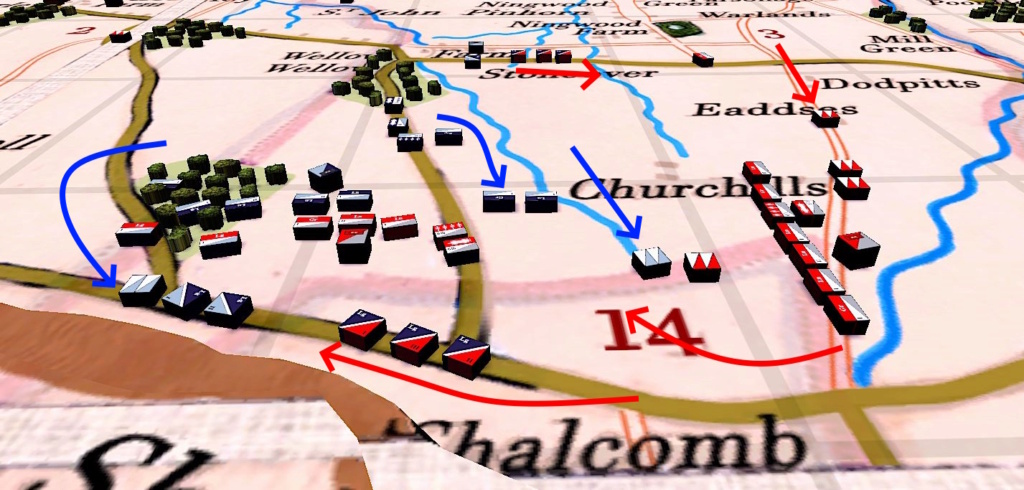
Chartres's forces manage to drive the British brigade back almost to the road; the clash between the two cavalries was settled on the British side, so the French cavalry was unable to attack the British rearguard and perhaps have decimated their ranks. Fullerton's brigade slowly moves to join its counterpart and block the way for the French, who are forced back to a defensive line between the two woods.

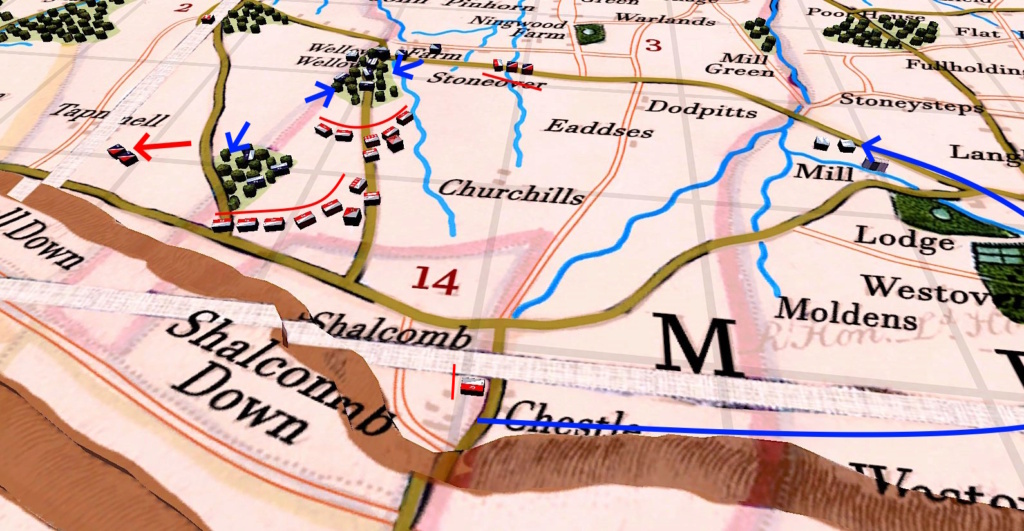
The final positions, with the French brigade sheltered between the woods and the nearby farmhouse, their remaining forces divided between the two woods and having to abandon their artillery on the plain.
Martin and Mr. Digby like this post
 Re: AAR Isle of Wight 1805 Napoleonic Kriegsspiel
Re: AAR Isle of Wight 1805 Napoleonic Kriegsspiel

Mr. Digby- Posts : 5769
Join date : 2012-02-14
Age : 65
Location : UK Midlands
Chorch likes this post
 Re: AAR Isle of Wight 1805 Napoleonic Kriegsspiel
Re: AAR Isle of Wight 1805 Napoleonic Kriegsspiel
The most curious aspect of the battle is that none of the commanders-in-chief were in the battle, so I had to develop it particularly, trying to capture the spirit of the notifications that had been made up to then by the commanders.
At the moment I like the balance in the results that are given in the Krieggspiel dices in the battle, but I only use the results of the central circles, not the numbers, to simplify the game.
Finally, the issue of couriers led me to consider that for this turn the French player could not receive the report of the battle from his brigade, considering that his couriers had been intercepted. So now he don't know the destiny of the brigade... But it is a question open to debate.
 Re: AAR Isle of Wight 1805 Napoleonic Kriegsspiel
Re: AAR Isle of Wight 1805 Napoleonic Kriegsspiel
For our tactical games at Little Gaddesden, we use a standard format for player orders. It has 3 columns. First is the name of the units. Second is where they are to go, and what they are to do when they get there. The third is actually the most important, and it's where the player can state the intent of the order. This is very useful for the umpires when (as in this case) a situation develops and the commander is not present.
If you'd like a pro-forma of the sheet we use, drop me a PM with your email.
Martin
Martin- Posts : 2523
Join date : 2008-12-20
Location : London
Chorch likes this post
 Re: AAR Isle of Wight 1805 Napoleonic Kriegsspiel
Re: AAR Isle of Wight 1805 Napoleonic Kriegsspiel
Regarding the subject of the messages, I think they are well structured, but I don't know if we write too much
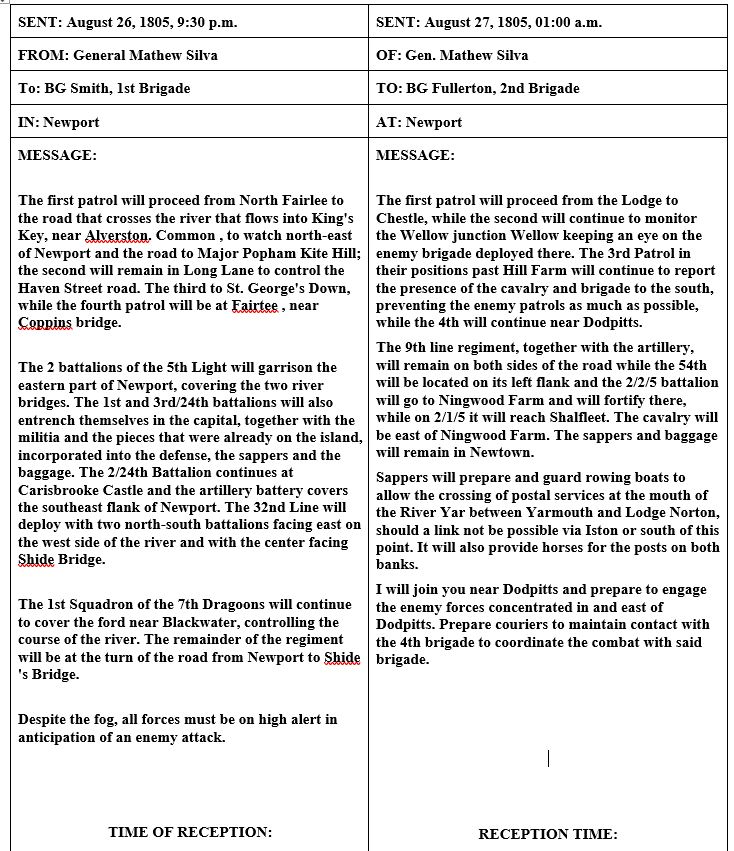
It is translated from Spanish form Google, but I hope it is understood...
My other concern is about the couriers, and for me it would be interesting to know when a courier transmits its message or not, depending
on the proximity of the enemy or being in its area of influence...
Mr. Digby likes this post
 Re: AAR Isle of Wight 1805 Napoleonic Kriegsspiel
Re: AAR Isle of Wight 1805 Napoleonic Kriegsspiel
Your format is different to ours, but that's ok. It works! The orders are also well-written, notwithstanding Google translate.
I assume the players are commanding division-sized forces, in which case that seems about the right level of detail too. If you had players commanding each brigade, then the division commander would ideally leave more discretion to them, by setting out the task in broad terms, and allowing them to send patrols, allocate forces, and make detailed dispositions at this level.
In your first example, it is implicit from the last sentence that the whole brigade is to adopt a defensive stance, so the intent is clear. It's slightly less so in the second example. It seems as if a part of the brigade is preparing for defence by fortifying, and part preparing to attack. That's not inherently wrong btw.....it may be exactly what the situation requires. But it does make it more difficult for the umpire to make decisions when acting as the NPC brigade commander, if the unexpected occurs. If I were umpiring that, I would nevertheless assume the player expects the whole brigade to act on the defensive until he arrives. And that may be exactly what he does want.
But it may not be. Let us suppose smaller than expected French forces are identified on the approach to Dodpitts. Should the whole brigade stand on the defensive, until the player's arrival, or should the brigade attack immediately? If the player wants the brigade commander to take that sort of opportunity, then it's a good idea to specify this intent.
Of course nothing is perfect, and one cannot plan for all contingencies. In the example above, the former approach might mean an opportunity missed, but the latter could lead to disaster if there are more French at Dodpitts than initially spotted. But by specifying their general intent, players can allow the umpires to make such decisions with more confidence that they are reflecting player's wishes. None of this implies the umpire should depart from common sense when assessing the situation. Intent is just one factor for them to take into account
Re couriers - we allow interceptions (on a die roll) if enemy forces are between sender and recipient. Even if the die permits the courier to get through, he might well be delayed - perhaps by some hours - due to the necessity of evading patrols etc. Have I understood your question correctly?
Hope that helps.
Martin
Martin- Posts : 2523
Join date : 2008-12-20
Location : London
Mr. Digby likes this post
 Re: AAR Isle of Wight 1805 Napoleonic Kriegsspiel
Re: AAR Isle of Wight 1805 Napoleonic Kriegsspiel
Thank you very much for your comments, I find them very useful to describe the different situations.
An interesting point is the use of the Table of the Attributes of the commanders that I posted in the first posts, so it is assumed that in a situation like Doddpitts the commander's value in defense and attack - apart from other attributes - can help the referee/Umpire to consider his position or his reaction to a situation of apparent danger to the player.
Other interesting point in the couriers is the absence or proximity of the enemy, but it can also be an indication that we are in enemy territory or not. I explain myself:
In the case of the Battle of Wellow Wellow, a daring courier with a good horse could have ventured around the south of the island, up north again across the hills and up to the French HQ. But it seemed a bit extreme to me, though not unrealistic. I found it more logical that the French couriers could not pass from the zone controlled by the British, and the French player does not know at this moment the fate of his brigade...
Generally, in the case of the French couriers on the Isle of Wight, it is clear that they are in enemy territory, so they always have a certain risk (I do not know if the good people of the island are very bellicose with the French
Obviously we are not in Spain, but I think that the roll of the dice should be modulated depending on the absence or not of the enemy, but also if one is found or not on enemy or enemy terrain. Well, these are some reflections that I do myself...
Mr. Digby likes this post
 Re: AAR Isle of Wight 1805 Napoleonic Kriegsspiel
Re: AAR Isle of Wight 1805 Napoleonic Kriegsspiel
Good point re commander attributes. It's another factor to guide umpire decision-making when a player is not present. When we run a traditional kriegsspiel, we don't use commander attributes. That's solely because the Prussians didn't in their training games. However there's absolutely no reason why you should not, and one could certainly argue it's more historical. In other types of game, we sometimes use them too
I also agree with your approach in the example you give re the Battle of Wellow Wellow. Whilst taking lengthy or convoluted detours might theoretically improve the chance of getting through, there is no way the French (or even at times the British) commanders will have enough information about the locations of both sides forces to determine such a route. The challenges facing the poor couriers should not be underestimated either.
You make an excellent point re the greater risk to French couriers in enemy territory. As you suggest, probably not as severe as in Spain. But nonetheless a real French disadvantage in this scenario.
Martin
Martin- Posts : 2523
Join date : 2008-12-20
Location : London
Mr. Digby and Chorch like this post
 Re: AAR Isle of Wight 1805 Napoleonic Kriegsspiel
Re: AAR Isle of Wight 1805 Napoleonic Kriegsspiel
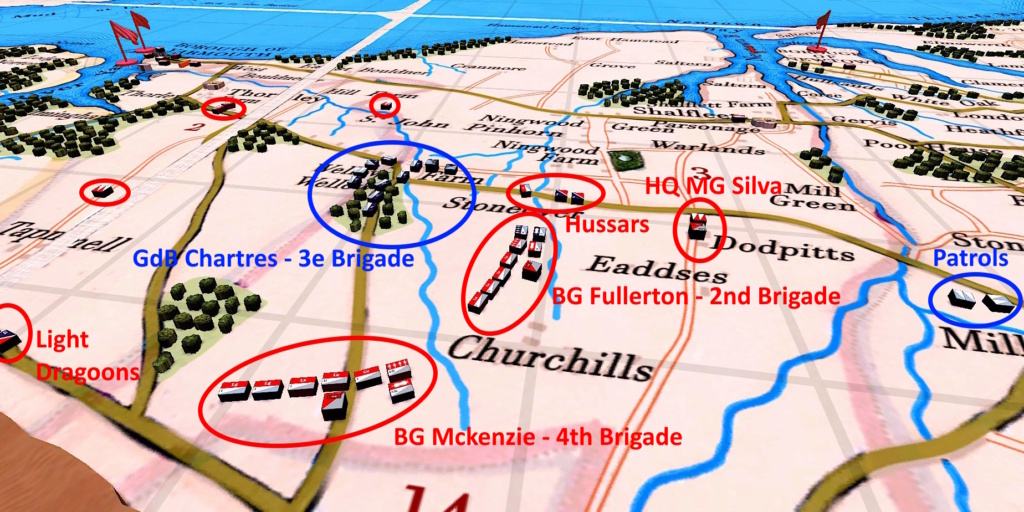
On the western front of the island, the 3rd French brigade is completely surrounded by the two British brigades, 2nd and 4th, and various detachments. The disadvantage is manifest and the British commander has approached Doddpitts to personally examine that position. But this seems to entail two problems: the first is that the French brigade is pinning two brigades from a strong defensive position, also with the alternative of moving further west in the hope that the British will follow in the event that they are caught head to Yarmouth which is not very protected nowadays. And the displacement of the British commander occurs at a time when the capital itself is about to be attacked by the French with numerical superiority...
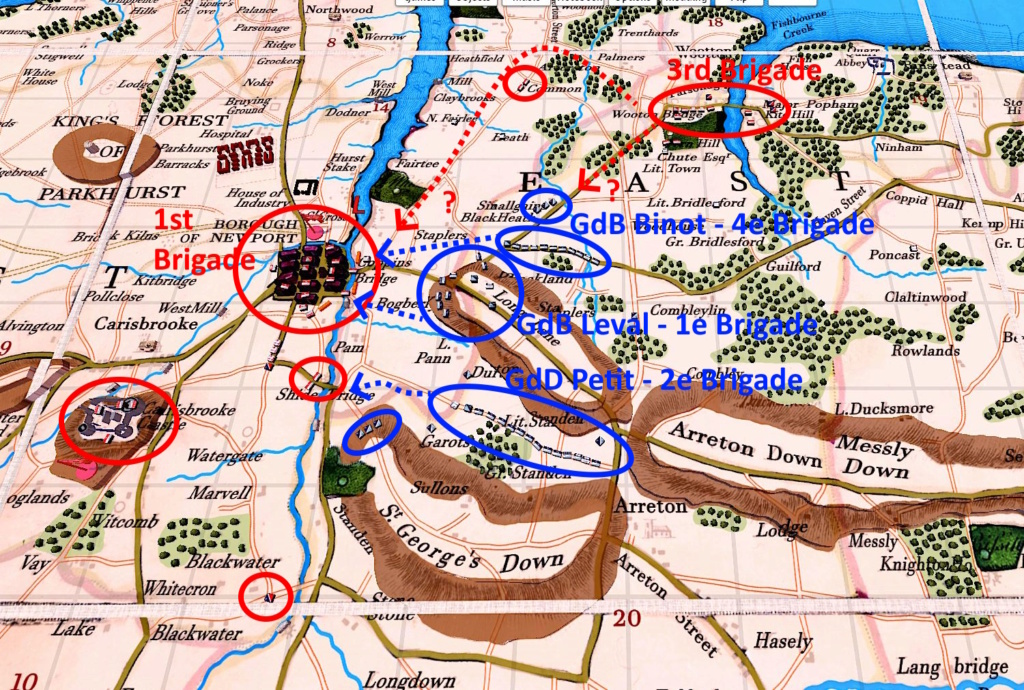
On the eastern front of the island, the three French brigades are at the gates of the capital, and the attack seems imminent. The disadvantage is 3:1, despite the defensive advantage of the river and that the defenses have been reinforced. The castle of Carisbrooke, from the time of Henry VIII, does not seem to be a defensive enclave that could withstand a prolonged siege... Another question is what the British 3rd Brigade will be able to do, if they join the defense, in which case they should make forced marches or attack the French brigade further north, hoping to divert troops from the attack on the capital.

The British position from Doddpitts
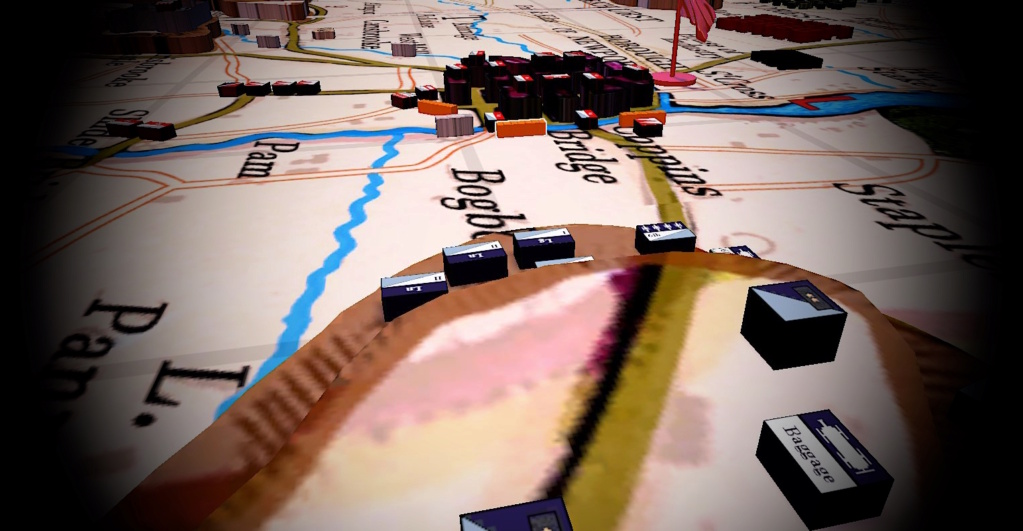
The French 1st Brigade in front of Newport.
Martin likes this post
 Re: AAR Isle of Wight 1805 Napoleonic Kriegsspiel
Re: AAR Isle of Wight 1805 Napoleonic Kriegsspiel
“It would have been better”, thought Jack, “if they had faced the enemy that first morning, when their blood was up and spirits high. Almost three days camping in the city had given them too much time to think. Now they had to steel themselves to face the enemy drawing up before them.”
The major could sense their mood. He strode out in front of the line and turned to address them. “Men of the Newport Militia! Listen to me!” he shouted. “Those men over there are just like you and I! Flesh and blood! There is but one difference: they are here to burn and loot, and worse! While you are stout-hearted Englishmen fighting for the land you hold dear! For your loved ones so close at hand! And believe me, my fellows, only you stand between those loved ones and the Frenchies! Now, your shot will do as much harm as any fired by a regular. Two volleys will thin them, I assure you, then they must come and fight us among the trees, and that will be their undoing! Stand firm, men, and victory is ours!” A cheer rose from the ranks.
The major nodded and paced along the line to deliver a similar address to the other companies. Jack took a deep breath and loaded his musket.
(Text partially modified from “Vectis - Monsieur Napoleon’s Most Perfidious Venture” Rulebook v. 3.1, (2007) by Mark Wightman)

The expected attack by the French troops takes place at the same time by the three bridges closest to Newport, Coppins, Pan and Shide. The arrival in the distance from the north of the 3rd British brigade of BG Hill, causes the 4th brigade of GdB Binot to have to divide its forces to stop the march of Hill's troops and be able to attack through the Coppins bridge that had been reinforced with barricades and defending troops. The 1st French brigade of GoB Leval attacks through the Pan bridge, but is also repulsed several times by regular and militia troops, before being able to set foot in the city, although reduced in numbers despite being able to pass its battery of artillery. Also in the south of Newport the French troops have had a rough passage of the bridge of Shide, by the defense of the militia from the city buildings, the distant fire of the batteries of the castle of Carisbrooke and the presence of cavalry of the 7th of light dragoons.

Panoramic view from the French headquarters on top of the hill opposite Newport and the deployment of the three brigades at 11:00 a.m., the appointed time for the attack.

The Newport takeover has proven to be a tough nut to crack during this morning turn. British resistance has been bitter, and regular and militia troops from the buildings and defenses on the bridges have made the French pay dearly for their attack on the bridges. Only the French brigade to the south has a momentary numerical advantage that can be favored by the arrival from the south of the regiment of the 5th French dragoons. But the fight is house to house and the French advance has been slowed down and with the risk that if the 3rd British Brigade overcomes the French defense, they will find themselves between two fires.
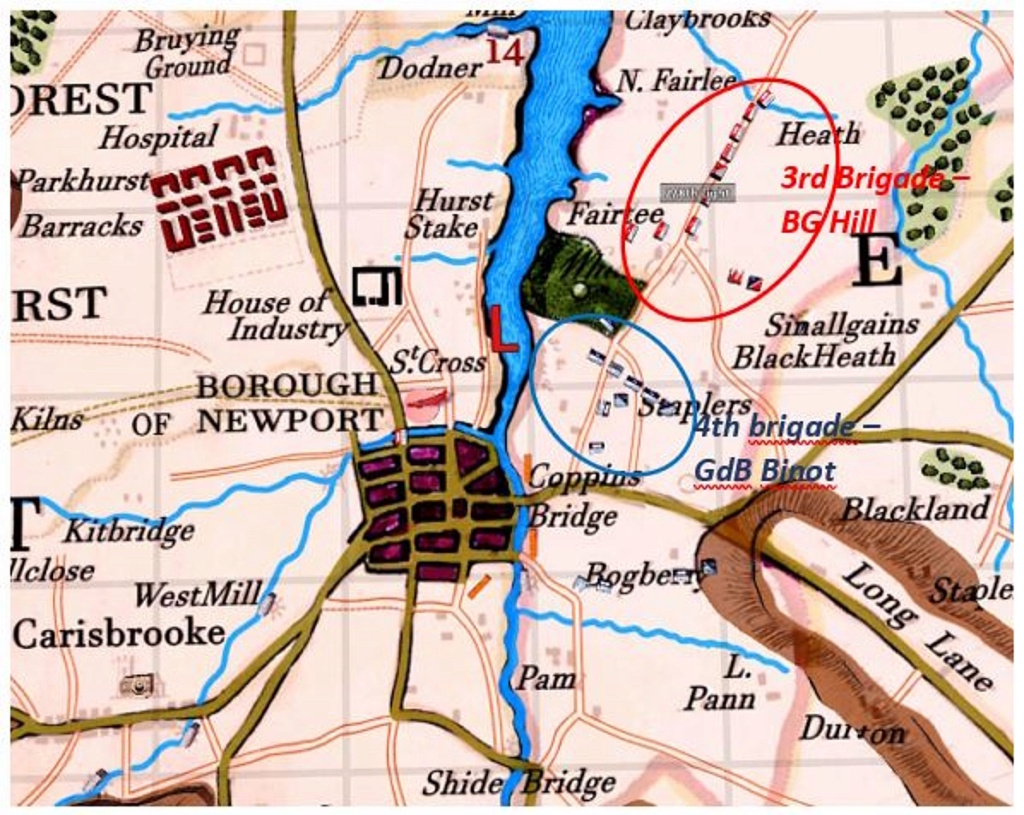
The arrival of the British 3rd Brigade from BG Hill at noon from the north hopes to break the French encirclement of the town.
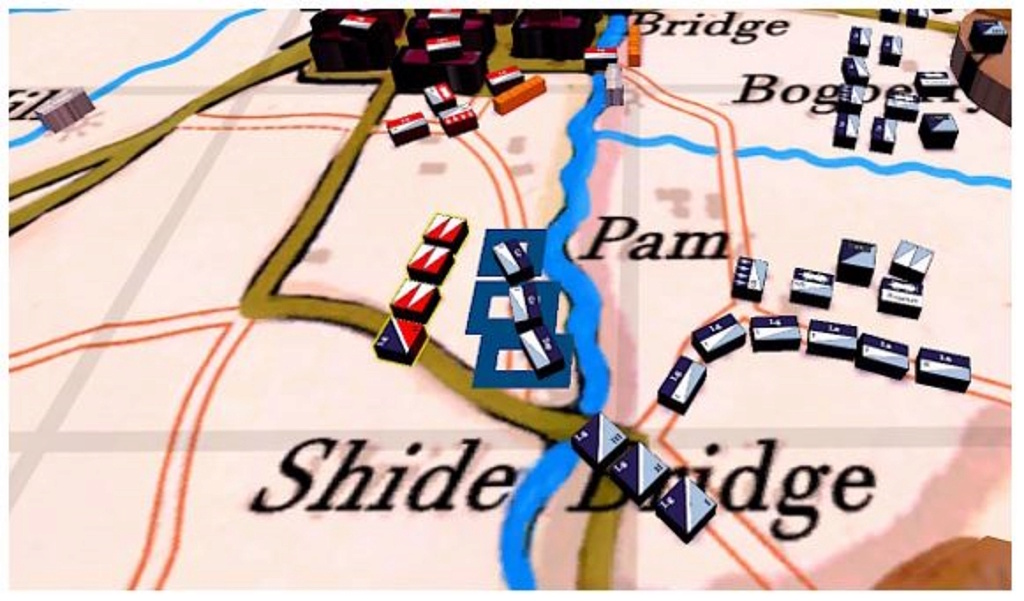
A moment of the march of the 2nd brigade of the GdB Binot over the Shide bridge, which has forced the vanguard of the column, made up of grenadiers and the sappers, to form squares, by action of British cavalry attacks, while the French cavalry brigade hastily crossed the river. Two British line units guarding the bridge were quickly incorporated into the outer defense of the city.
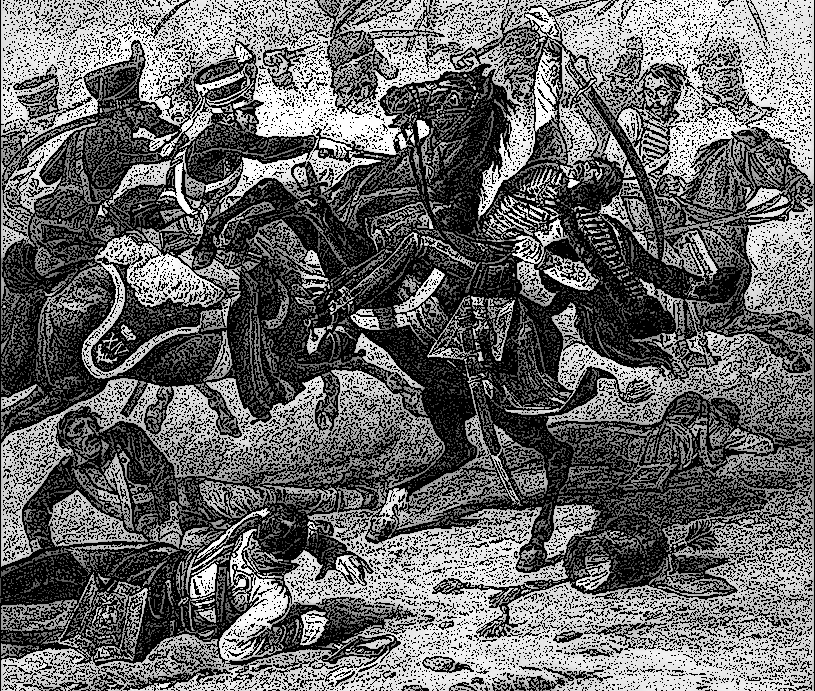
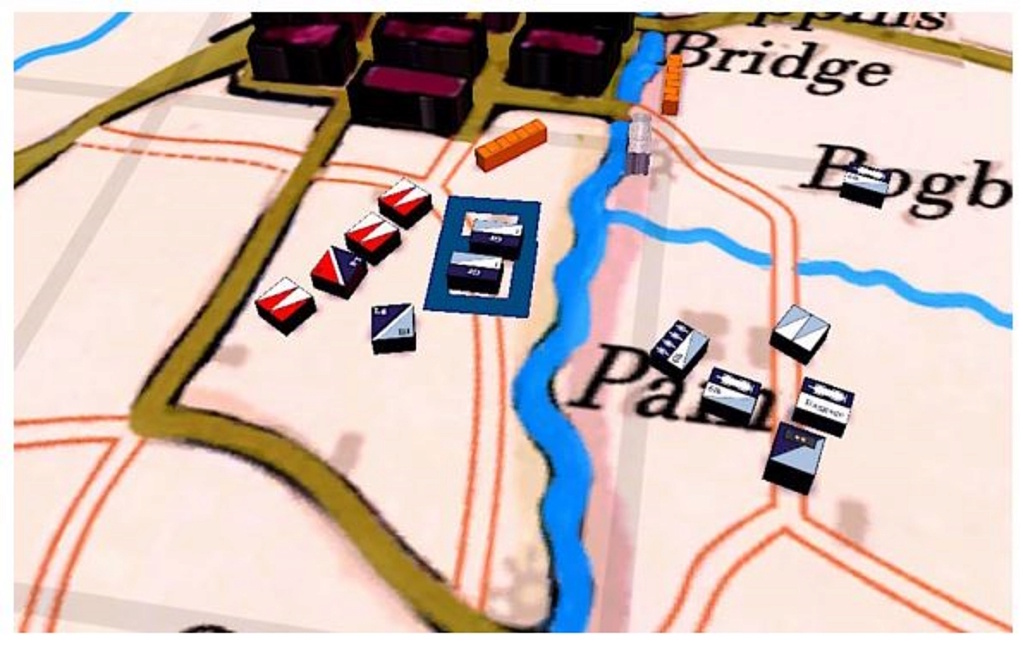
Another moment of the passage of the 2nd French brigade over the Shide bridge. The artillery from Carisbrooke Castle has taken its toll on the enemy cavalry, as well as repeated attacks by English cavalry. Despite this, several French units of the line have managed to penetrate the gardens surrounding the south side of Newport and have forced their defenders to take up positions in the houses and push the battery back and position it on the street. The enemy artillery has also made it easier for the French grenadiers, after forming several squares, to enter the city.

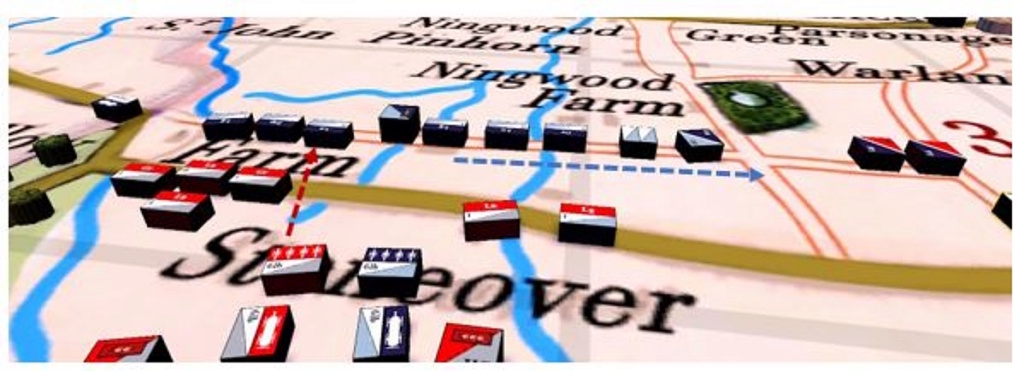
On the west side of the island, the 3rd French Brigade, blocked at Wellow Wellow by two British brigades, caused GdB Chartres to take a desperate exit to the east, towards the capital, before being blocked entirely between the forest and the village of Wellow Wellow. Taking advantage of the secondary road 200 m to the north of the main one, the French troops led by just over a squadron of cavalry attacked the two squadrons of the 5th Hussars guarding the road and the French horsemen fell back, although with few losses. With time against him, the French commander made his 450 square grenadiers advance forming squares, who after repeated charges, helped by the rest of the French troops, pushed back the British cavalry and two British units, one of the line and the other light, and the French head quickly north to Ningwood Farm and head east to the capital... But that goal may be unattainable if the British brigades mount a determined pursuit.

Taking advantage of the fact that we had the most detailed map of Newport at the bottom left of the map, we have moved the fight into the city, leaving the original pieces at the boundaries of the drawing and copying them scaled x 6, on the Newport city map. Although they are 6 times bigger, they are not to scale with the map, because it was an afterthought, and to better define the attacks. But the general idea is what is described. Anyway, I'll try to make the scale more approximate next turn.
Last edited by Chorch on Fri Mar 31, 2023 8:15 am; edited 1 time in total
Martin and Mr. Digby like this post
 Re: AAR Isle of Wight 1805 Napoleonic Kriegsspiel
Re: AAR Isle of Wight 1805 Napoleonic Kriegsspiel

Mr. Digby likes this post
Page 1 of 2 • 1, 2 
 Similar topics
Similar topics» Sunday 20 May 2018 Napoleonic Kriegsspiel
» Sunday 24 June Napoleonic Kriegsspiel
» Napoleonic naval Megagame / Kriegsspiel, Hemel Hempstead 2008
» 1805 Project
